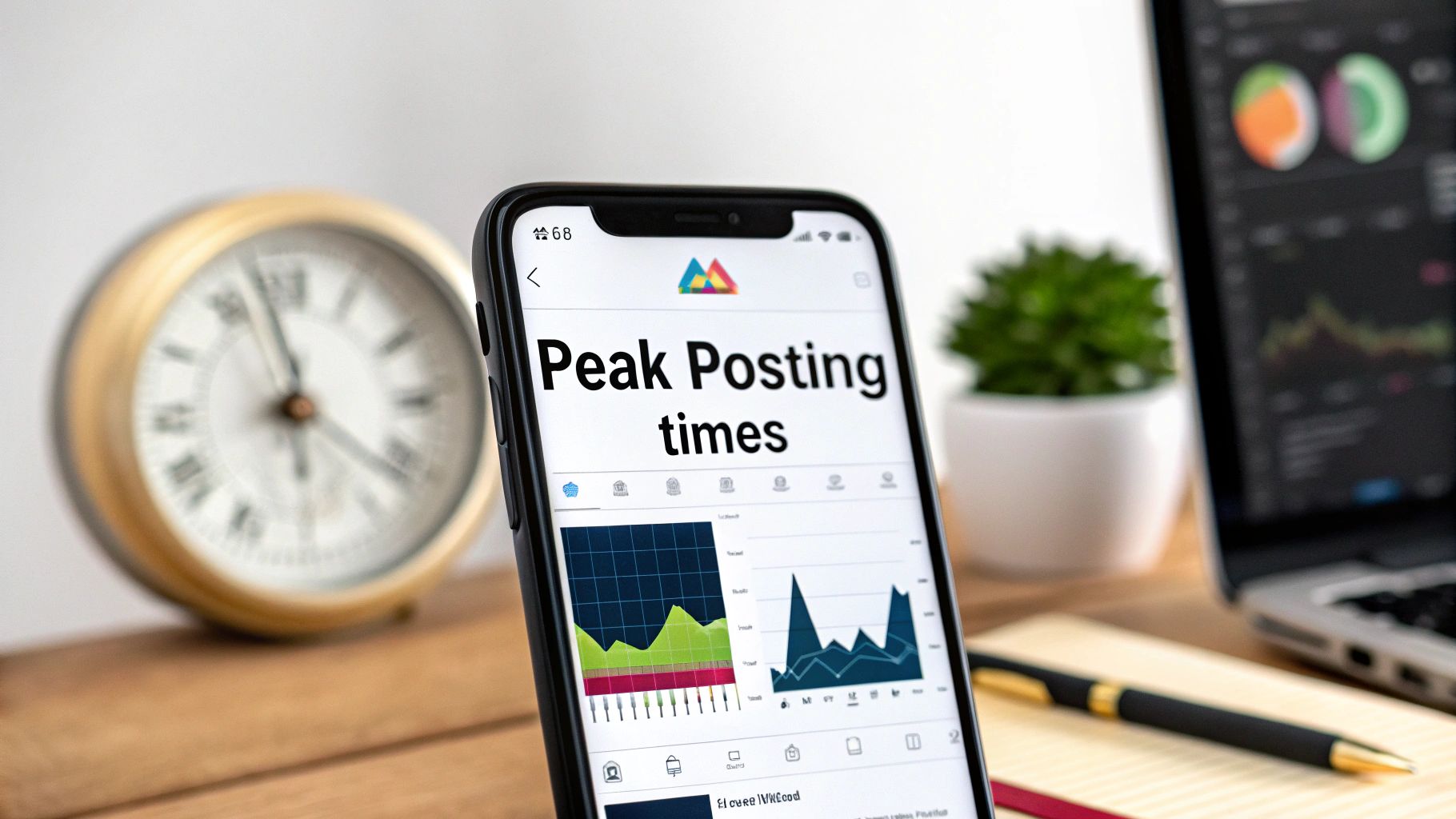
Peak Posting Times Instagram: Maximize Your Reach
Learn the top peak posting times on Instagram for your audience. Discover proven tips to boost your engagement with peak posting times instagram.
Let's be real for a second. We've all seen those infographics floating around, the ones promising the single "best time to post on Instagram" for earth-shattering engagement. But relying on those generic charts is an outdated strategy.
The truth is, there's no magical posting time that works for everyone. The real key to getting more eyes on your content is figuring out your unique audience. Finding your brand’s peak posting times on Instagram is a personal journey, not a one-size-fits-all formula.
Why Generic Posting Times Are Holding You Back
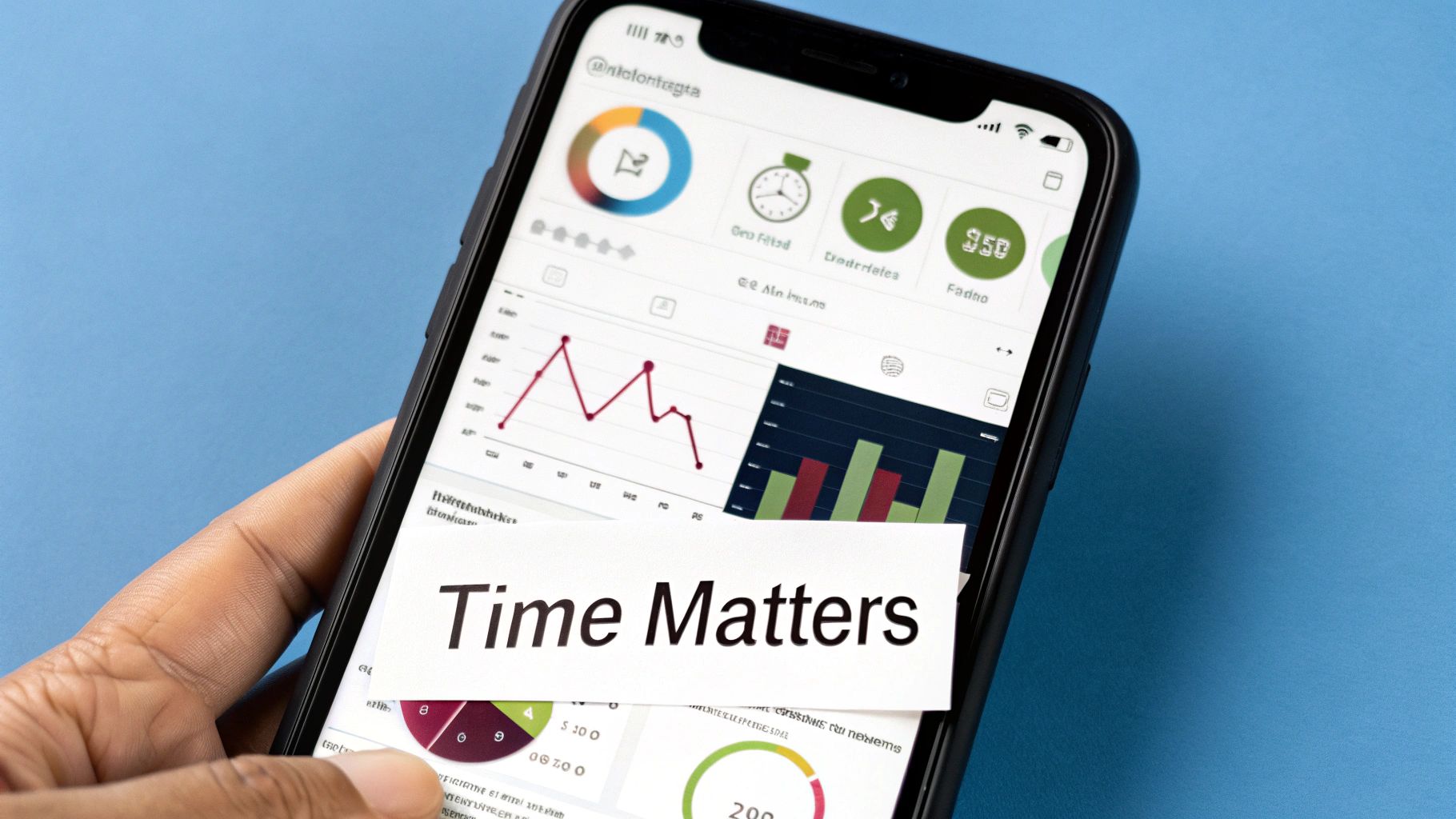
Those colorful charts offer a tempting shortcut, but they almost always deliver lackluster results. Why? Because they treat every single Instagram user as one big, monolithic blob.
Think of it like this: a major TV network decides to air its season finale at 9 PM Eastern Time. That's great for people in New York, but it’s 6 PM for viewers in Los Angeles, midnight in London, and the crack of dawn in Sydney. A huge chunk of the audience completely misses the live event. Generic posting schedules work on the exact same flawed logic.
Your Audience Is Unique
The reality is your followers have their own lives, their own routines, and their own digital habits. A brand targeting U.S. college students will probably find their audience is most active late at night, scrolling before bed. But a B2B software company aiming for professionals in Europe will see engagement pop during their 9-to-5 workday.
These crucial differences are shaped by a few key things:
- Location and Time Zones: This is the big one. Where your followers actually live matters more than anything else. An audience split between North America and Australia needs a totally different approach than one based entirely in a single country.
- Age and Occupation: A high schooler's daily scroll is worlds apart from a 40-year-old executive's. Their respective "downtime" for checking Instagram just won't line up.
- Industry Niche: Followers of a fitness influencer are probably online first thing in the morning or right after work. Meanwhile, fans of a food blogger might be most active right around lunchtime or dinner.
The core takeaway is simple: Your brand's peak posting times are determined by your audience's behavior, not a universal calendar. Relying on generic advice means you're almost certainly missing your most engaged followers.
This is the first real step toward building a smarter, data-driven posting strategy. Once you move past the one-size-fits-all advice, you can start making decisions based on what your actual data is telling you. This is where using the analytics tools inside platforms like ViewPrinter becomes essential for uncovering those personalized insights and making sure your content lands with maximum impact.
Decoding Global Instagram Activity Rhythms
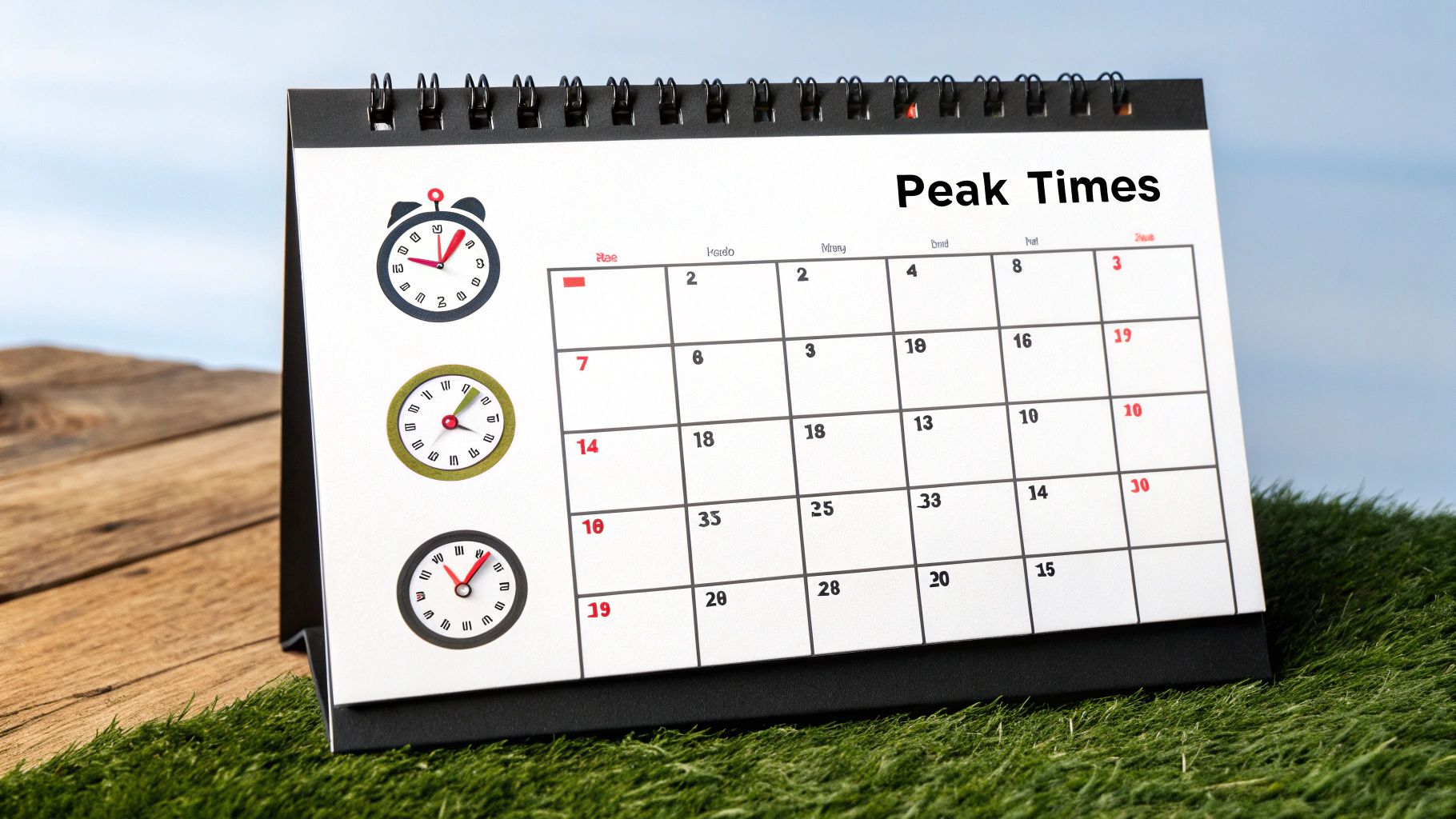
Before you can zero in on the perfect posting schedule for your brand, it helps to zoom out and look at the bigger picture. When are people actually using Instagram around the world?
Think of the platform as a massive digital city that never sleeps. While it's always humming with activity, there are clear "rush hours" when the digital streets are absolutely buzzing with traffic.
These general windows of high activity give you a solid foundation for your strategy. They’re driven by the shared daily and weekly rhythms of millions of people. Understanding these macro-trends is your first step toward making smarter decisions about when to publish your content.
For instance, two of the most reliable high-traffic periods are weekday lunch breaks and the hours right after work. From around 11 AM to 2 PM, people take a mental break, and scrolling through Instagram is a go-to way to unwind. Likewise, after 5 PM, as the workday wraps up, users log on to catch up, relax, and be entertained.
The Big Shift Toward Evening Engagement
For years, marketers swore by mid-morning and early-afternoon slots. But recent data paints a more complex picture, revealing a major shift toward evening activity. And honestly, it just makes sense—once people are done with their daily grind, they have more dedicated time to actually engage with content, not just mindlessly scroll past it.
An in-depth analysis of 2 million Instagram posts discovered that the most powerful peak posting times on Instagram are now concentrated in the late afternoon and evening. The single best-performing slot was Thursday at 9 PM, with engagement also spiking on Sunday and Wednesday nights between 8 PM and 10 PM. The data shows a steady climb in user activity starting around 1 PM on weekdays, hitting a peak between 3 PM and 5 PM, and rolling right into a strong evening session. You can read the full research about these Instagram posting trends to see the complete breakdown.
This shift means that if you're only posting in the morning, you're likely missing the primetime window when your audience is most ready to like, comment, and share. The early morning hours (1 AM to 4 AM) consistently show the lowest engagement across the board.
General Global Posting Windows
While your own audience data is the ultimate truth, these global patterns provide an excellent starting point for your experiments. They represent the collective pulse of the entire platform.
Here are the broadly recognized high-traffic windows to start with:
- Weekday Mornings (10 AM - 12 PM): This catches the late-morning coffee break scrollers.
- Weekday Afternoons (2 PM - 5 PM): This hits that end-of-workday wind-down period.
- Weekday Evenings (7 PM - 10 PM): This reaches users during their primary downtime at home.
- Weekends (Varies): Saturdays and Sundays are less predictable, but late mornings and evenings often show strong activity.
Think of these global rhythms as your baseline. They tell you when the largest potential audience is online. The next step is to layer your own specific audience data on top of this framework to find the sweet spot that’s uniquely yours.
Finding Your Audience's Digital Footprint
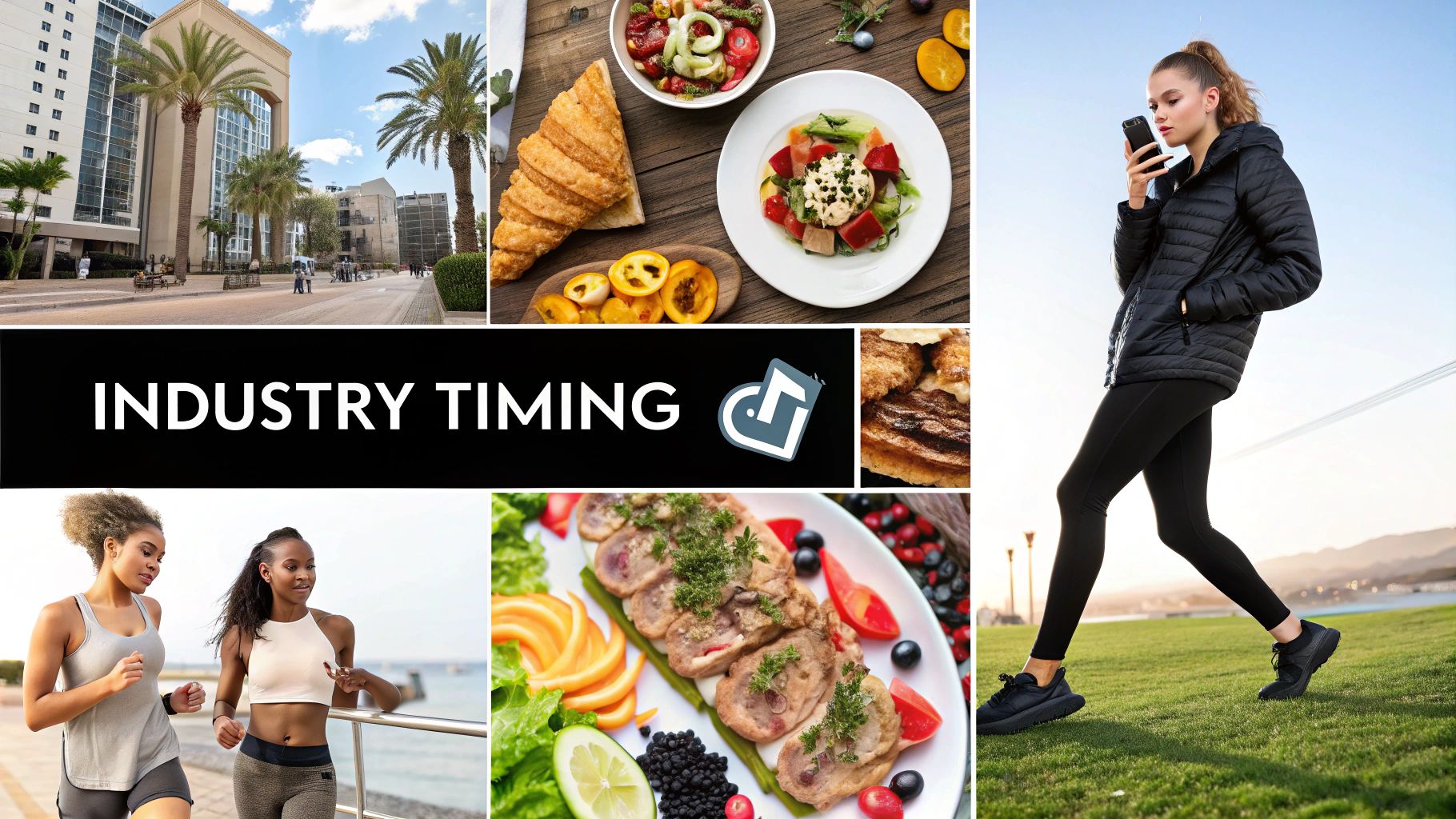
Global trends and industry-wide averages are a fantastic starting point. But that's all they are—a start. If you really want to see your engagement take off, you have to stop guessing and start listening to what your own audience is telling you.
The most valuable data isn't in some generic study; it's tucked away right inside your Instagram account, waiting to be discovered. This is where you trade broad advice for a sharp, competitive edge. By digging into your own analytics, you can find the peak posting times on Instagram for your specific followers. Think of it like finding their unique digital footprint—a clear path leading straight to their attention.
Unlocking Your Data with Instagram Insights
Instagram’s built-in analytics tool, called Insights, is surprisingly powerful. You'll need a Business or Creator account to get access, but once you do, this data becomes your single source of truth. The best part? It's straightforward to use and gives you a direct window into your audience's behavior.
Here’s how you can find this goldmine of information:
- Head to your profile and tap the "Professional Dashboard."
- Look for "Account Insights" and tap "See all."
- Choose "Total Followers" to get a full breakdown of your audience.
- Scroll right to the bottom to find the "Most Active Times" section.
This little dashboard lets you see activity by the hour for every day of the week. You'll see obvious peaks and valleys, showing you exactly when your followers are most—and least—likely to be scrolling their feeds.
Your own data will always beat general advice. Discovering that a huge chunk of your audience is online at 9 PM on a Tuesday is a game-changing insight no global study can give you. This is the real foundation of a content strategy that actually works.
Reading the Tea Leaves of Your Audience Activity
Once you’re looking at your active times, you’ll see a simple, visual chart of your audience’s daily habits.
The chart below is a perfect example of what this "Most Active Times" data looks like inside Instagram Insights.

For this account, the graph makes it crystal clear: follower activity starts to build around noon and hits its absolute peak at 9 PM. Posting at 9 AM would be a total waste, completely missing this prime window.
While you're in your Insights, there are two other key metrics you need to check out:
- Top Locations: This shows you the cities and countries where your followers live. This is absolutely critical for figuring out time zones, which we'll dive into next.
- Age Range: This helps you paint a picture of your typical follower. A younger crowd might be night owls, while an older demographic could be scrolling first thing in the morning.
When you start combining these data points, you stop throwing content at the wall and start posting with surgical precision. You can learn more about how to define these groups in our complete guide to social media audience targeting. It's this kind of personalized insight that lets you schedule content with confidence, knowing you’re reaching people exactly when they’re ready and waiting to engage.
Mastering Time Zones for a Global Audience
You’ve figured out when your audience is most active. Huge win! But then you look closer and realize your "Most Active Times" chart is a jumble of different continents.
This is a classic growing pain for successful accounts. Maybe your brand is based in New York, but your peak engagement is actually happening at 3 AM your time, all thanks to a massive following in London.
If you only post during your own business hours, you're flat-out ignoring a huge chunk of your audience. The trick is to shift your mindset. You need to post for their prime time, not yours. This is the secret to finding your true peak posting times on Instagram when you have fans all over the world.
Start by diving back into your Instagram Insights and find the "Top Locations" report. Don't just skim the countries—drill down to the cities. This gives you the exact time zones you need to focus on.
Prioritizing Your Key Time Zones
Don't panic. You don't need to post around the clock. Instead, focus your energy where it'll make the biggest difference. A simple framework is all you need.
First, identify your top three to five cities. Let's say your audience is booming in Los Angeles, Toronto, and Sydney. Just like that, you have three distinct peak windows to target. The goal is to schedule your most important posts to catch that evening scroll-time (think 7 PM to 10 PM) in each of those hubs.
Data from over 50,000 Instagram accounts shows just how wild these regional differences can be. For example, peak engagement in Australia often hits between 4 PM and 7 PM AEST. But on the other side of the world, audiences in Bangladesh are most active much later, between 6 PM and 11 PM IST. If you want to go deeper on this, Social Pilot's global data analysis is a fascinating read.
The takeaway is clear: A one-time-fits-all approach fails a global audience. To maximize reach, you have to adapt your schedule to the local routines of your most important followers.
Sometimes, you can get lucky and find a sweet spot that covers multiple regions. A post at 11 AM EST, for instance, often catches the lunchtime crowd in North America while also hitting the late-afternoon scrollers in Western Europe.
This targeted strategy ensures your best content doesn't drop while your key followers are sound asleep. This is where a scheduling tool like ViewPrinter becomes your best friend, letting you plan and automate posts for these perfect, time-zone-specific windows—without you having to wake up at 3 AM to do it.
How Your Industry and Content Shape Your Peak Times
Okay, so you've nailed down when your audience is scrolling. That's a huge win. But there’s another layer to this onion: the type of content you're sharing and the industry you're in. These factors dramatically shift your peak posting times on Instagram.
It’s not enough to know when your followers are online. You have to catch them in the right frame of mind for what you're actually posting.
Think of it like this. A B2B tech company will probably get the best traction posting industry news or professional tips smack in the middle of a 9-to-5 workday. Their followers are already in that work-focused headspace, hunting for useful insights. On the flip side, a local restaurant's audience is likely thinking about dinner around late afternoon or scouting for weekend brunch spots on a Saturday morning. Same audience, different mindset.
Matching Your Content to Your Audience's Mindset
This idea applies to specific content formats, too. A quick, punchy motivational quote? Perfect for a Monday morning when everyone needs a little boost. But a detailed, 10-minute Reel tutorial is a much better fit for a lazy Sunday afternoon when people have the time to kick back and really absorb something new.
The magic formula for engagement happens when three things click: your audience's active hours, their current mindset, and the content format you're using. When those align, you're golden.
Data from major social media studies backs this up. While weekday afternoons around 3 PM are often a great time for broad, global reach, things shift on weekends. People tend to engage more between 5 PM and 6 PM. Mondays often see steady engagement from 10 AM to 4 PM as people take breaks from the grind. This shows just how much user behavior changes day-to-day, opening up different windows of opportunity. For a deeper dive into these patterns, you can discover more insights about Instagram posting times on Shopify.com.
To give you a clearer picture, here's a table showing how different industries and content types might align with user behavior throughout the week.
Sample Posting Times by Industry and Content Type
| Industry / Content Type | Potential Peak Day(s) | Potential Peak Time Window | Rationale | | :--- | :--- | :--- | :--- | | B2B / Professional Tips | Monday - Friday | 10 AM - 4 PM | Audience is in "work mode" and receptive to career or business-related content during their workday and breaks. | | Local Restaurants / Food | Wednesday - Saturday | 4 PM - 7 PM (Weekdays), 10 AM - 1 PM (Weekends) | People are planning dinner during the week and looking for brunch or weekend dining options on Saturdays and Sundays. | | Fashion & E-commerce | Friday - Sunday | 5 PM - 8 PM | Followers are often in a "shopping mindset" in the evenings and on weekends, ready for style inspiration or deals. | | Fitness & Wellness | Monday, Saturday, Sunday | 6 AM - 9 AM, 6 PM - 8 PM | Early birds look for workout motivation, and weekend warriors have more time. Evening slots catch the post-work crowd. | | Long-Form Reels / Tutorials | Sunday | 2 PM - 6 PM | Viewers have more leisure time for in-depth content that requires more attention and time to watch. |
Remember, these are starting points. The real power comes from combining these general principles with your own specific audience data.
This chart really drives home the impact of strategic scheduling, comparing key metrics before and after getting it right.
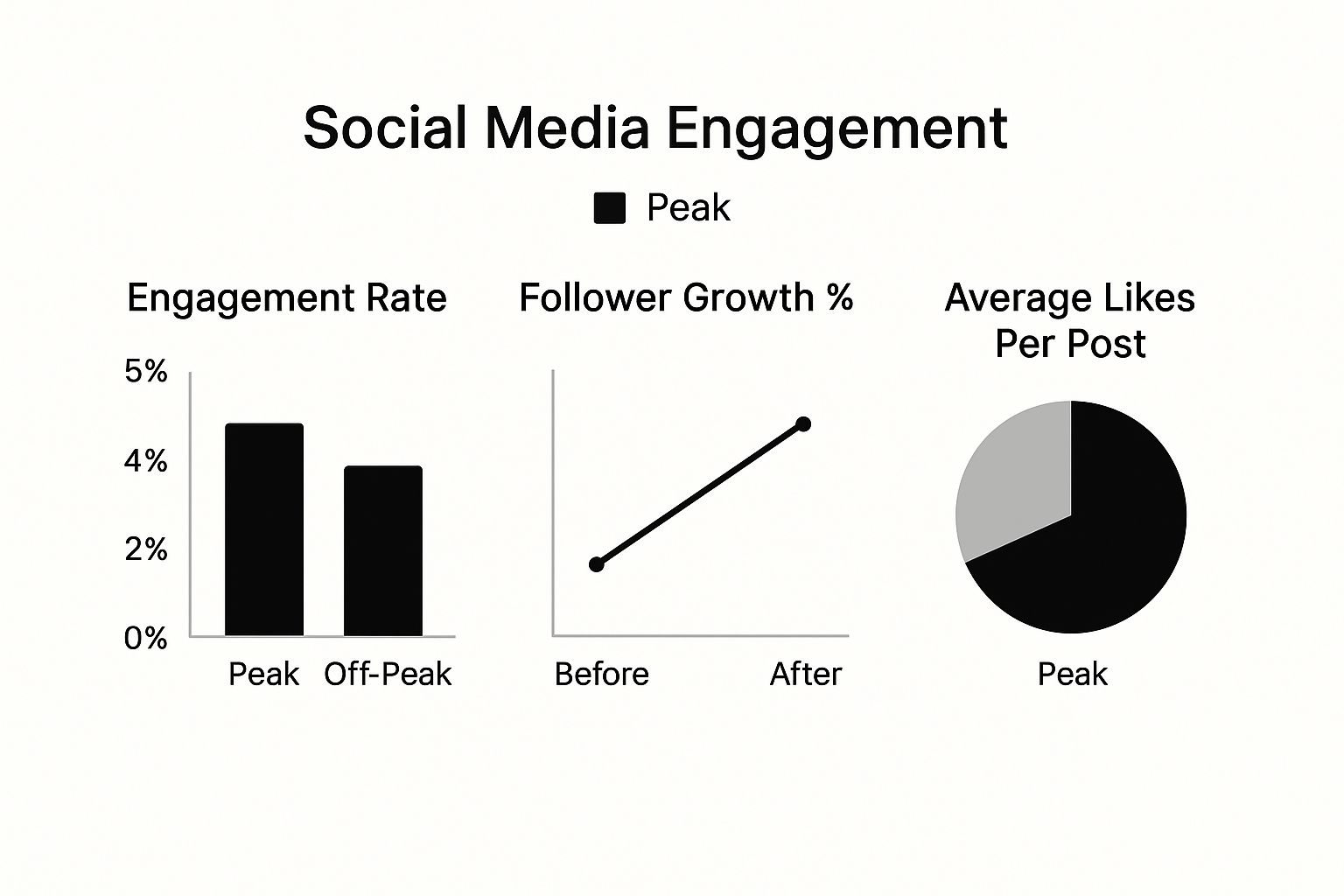
The proof is in the numbers. Posting at the right time isn't just a minor tweak—it's directly tied to better engagement and faster follower growth.
Alright, you've done the hard work. You know why generic posting times don't cut it, you've peeked behind the curtain at how the world scrolls, and you've found the specific digital pulse of your own audience.
Now for the fun part: turning all that data into a real, high-impact posting schedule. This is where the theory gets left behind and you start building something that actually works for you.
Think of it like being a chef. You’ve gathered all your premium ingredients—your audience's most active hours, their time zones, and the content they crave. Now it's time to combine them into a signature dish.
Your Four-Step Action Plan
Don't overthink it. Building your schedule is just a logical process of layering one insight on top of another. It's a simple, repeatable checklist that takes you from raw data to a smart, automated plan.
- Pinpoint Your Peaks: First, open up your Instagram "Most Active Times" chart. This is your foundation. For each day, find the top 2-3 windows where your audience is most engaged. Just jot them down.
- Layer on Locations: Now, look at your "Top Locations" data. If your chart says 9 PM is a peak time, but your biggest audience is in London, you need to be posting at 9 PM GMT—not 9 PM your local time. Always prioritize the time zones where your most valuable followers live.
- Match Content to Mindset: Think about what people are doing during those peak times. That lazy Sunday afternoon peak? Perfect for a detailed Reel. The frantic weekday lunch rush? That’s prime time for a quick, scannable carousel. Align your content with their likely mood.
- Schedule and Forget It: This is the final, crucial step that guarantees you'll actually be consistent. We have a full guide on how to schedule Instagram posts that walks you through the setup. Using a scheduler like ViewPrinter means you can load up your best content into these perfect time slots without having to be glued to your phone at all hours.
The 30-Day Test and Refine Cycle
Here’s the thing: your first schedule is a hypothesis. A really, really good one, but still a starting point. The best accounts on Instagram don't set their schedule in stone; they treat it like a living, breathing thing.
Commit to your new schedule for 30 days. That’s it. Track your reach, engagement rate, and follower growth. At the end of the month, see what worked. Did your Wednesday evening posts blow everything else out of the water? Great, double down on that. Did weekend mornings turn out to be a dead zone? Fine, move that content somewhere better.
This constant cycle of testing, measuring, and tweaking is what separates the good accounts from the truly great ones. It ensures your strategy evolves right alongside your audience, keeping you perfectly in sync with their habits and getting the absolute most out of every single post.
Got Questions About Instagram Posting Times? We’ve Got Answers.
So, you've got the data and a rough idea of when your audience is online. But diving into the nitty-gritty of scheduling always brings up a few more questions. That's a good thing. Nailing these details is what separates a decent strategy from a truly great one.
Let's clear up some of the most common head-scratchers about posting on Instagram.
How Often Should I Actually Be Posting?
This one’s simple: consistency trumps frequency.
It’s far better to share 3-5 genuinely great posts per week, every week, than it is to spam your followers’ feeds with mediocre content just to hit a daily quota. Pushing out too much can lead to audience burnout, and it tells the algorithm your content might not be worth showing.
Find a rhythm you can stick with. Once you've established a consistent flow, keep a close eye on your analytics. In the long run, quality is what builds a loyal audience and drives real growth.
Does Timing Matter for Stories and Reels, Too?
You bet it does. While they behave differently than a standard feed post, timing is absolutely crucial for maximizing the reach of both Stories and Reels.
- For Stories: Think of these as a real-time update. You want to post them right before your audience's most active periods. This pushes your Story to the front of their queue the moment they open the app, getting you maximum views before it disappears in 24 hours.
- For Reels: The first couple of hours after posting are make-or-break. Get your Reels up 1-2 hours before peak times. The goal is to create an initial burst of likes, comments, and shares that signals to Instagram, "Hey, people love this!" The algorithm then rewards that early momentum by pushing it to a much wider audience.
The initial velocity of a Reel is everything. A well-timed post can be the difference between a few hundred views and a video that truly takes off.
What If My Audience Is in Different Time Zones?
First off, congrats! This is a fantastic problem to have because it means your brand is growing globally. When your followers are split between, say, New York and London, you have a couple of smart options.
You could try posting twice on your most important days, hitting the evening peak for each group. Or, you can find a sweet spot that overlaps—a time that’s late afternoon for one audience and morning for another. This little bit of strategy can make a huge difference. For more ideas on how to get your content seen, check out these actionable social media engagement tips.
Ready to stop guessing and start scheduling with confidence? ViewPrinter's AI-powered platform analyzes your unique audience data and automates your posting schedule for every time zone. It ensures your content always lands in that peak window for maximum impact. Plan, create, and schedule your posts by visiting https://viewprinter.tech.